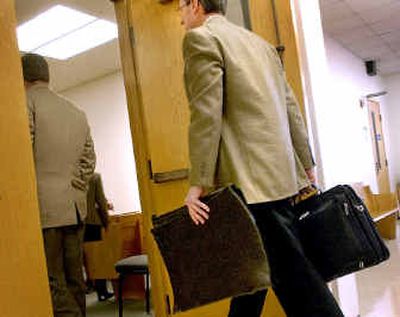BNSF says depot leaks fixed

Although several small leaks remain at BNSF Railway’s fuel depot near Hauser, Idaho, major improvements have been made and the facility is ready to resume operations, according to testimony Thursday by railroad executives and experts hired by BNSF.
In the two months since a judge ordered the depot closed because of repeated problems, BNSF has installed an electronic detection system for fuel leaks and has conducted a massive overhaul of the bathtub-like fuel protection barriers beneath the depot, said Steve Millsap, a BNSF assistant vice president.
“The system has integrity and it will prevent anything from reaching the aquifer,” testified Millsap, who was one of at least four senior executives from the railroad flown in for the hearing.
Attorneys for the Idaho Department of Environmental Quality aren’t convinced the depot no longer threatens the Spokane Valley/Rathdrum Prairie Aquifer, which supplies drinking water to about 500,000 people. The agency argued successfully in February for a court-ordered closure after a series of problems were reported at the high-speed fueling facility, including a cracked pipe that dripped at least 2,000 gallons of diesel and motor oil into the groundwater.
“This facility is not ready to operate,” said Deputy Attorney General Garrick Baxter.
In five hours of testimony Thursday, BNSF executive Millsap and two engineering experts hired by the railroad described improvements to the depot. Most of the focus was on repairs made to cracks found across the concrete refueling platform, as well as leaks discovered in the pair of plastic membranes buried about 10 feet below the platform.
Crews applied five layers of specialized sealants to the concrete surface, boosting the platform’s impermeability “a thousand percent, easy,” Millsap said.
A follow-up question by BNSF attorney Rusty Robnett prompted snickers from depot opponents in the courtroom gallery. “Is this a state-of-the-art concrete sealing program?” Robnett asked.
Millsap did not flinch. “It’s the best that we could find,” he answered.
Construction of the depot atop the region’s underground water supply prompted widespread public concern, but railroad officials promised state-of-the-art engineering. The first leak was discovered three months after the depot was opened in September.
Pressurized water tests conducted in recent days have revealed at least one leak in the inner liners below both the refueling platform and the fuel storage tank area, according to testimony. The leaks are estimated to be smaller than the diameter of “pencil lead,” said Bob Wallace, a Seattle-based engineer and liner expert from URS Corp., which was hired by BNSF.
“We’re talking about very, very small holes,” Wallace said. “Maybe if you got down on your hands and knees on the liner you might be able to find them.”
Wallace, who has been the certifying engineer on the installation of at least 200 million square feet of buried liners, said it’s common to have one to four small holes per acre of liner because of human error. Holes at the Hauser depot do not pose a threat, Wallace said. Sealed concrete should prevent fuel from ever reaching the first liner and all evidence shows the outermost plastic liner to be free of holes. A new electronic leak-detection system will immediately notify BNSF workers of liquids reaching the liner, he said.
Fresh concrete was expected to be poured Thursday night on the last of 30-some holes cut in the refueling platform over the course of the repair work. The concrete normally takes 28 days to cure, Millsap said, but the company is using a specialized mixture that will reach sufficient strength within three or four days. Additional curing will be needed, however, before the new concrete can be sealed.
BNSF officials said they want to reopen the depot early next week. DEQ Attorney Baxter said that seems too early.
“So you would begin to operate before you put the sealant on?” Baxter asked.
Millsap replied that concrete is impervious to spills during the curing phase.
The testimony Thursday offered no clear insights into why 5,000 feet of cracks developed on the refueling platform. Outside experts who have visited the site have suggested the cracks are the result of mistakes made during the construction process.
Railroad officials say problems at the depot have cost at least $10 million to repair.
Most of Thursday’s hearing had witnesses for BNSF providing evidence that the depot could safely resume operations. On Monday, the railroad will introduce an additional argument, that the state of Idaho has no legal right to further restrict the company’s business. BNSF has brought in a Washington, D.C., attorney to argue that federal interstate commerce laws supercede state laws.
Railroad spokesman Gus Melonas said Monday’s testimony will include figures on the amount of money being lost from shipping delays caused by the closure. The depot is the fastest pit stop on the company’s northern mainline and is capable of shaving up to seven hours off a refueling stop.
Idaho State Rep. Bob Nonini, R-Coeur d’Alene, emerged from the court hearing Thursday saying the state should not allow the depot to reopen.
“It shouldn’t be there,” Nonini said. “The aquifer is too precious of a resource.”